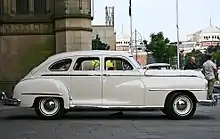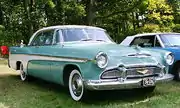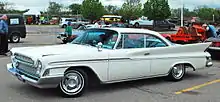DeSoto (automobile)
DeSoto (sometimes De Soto) was an American automobile marque that was manufactured and marketed by the DeSoto division of Chrysler from 1928 to the 1961 model year. More than two million passenger cars and trucks bore the DeSoto brand in North American markets during its existence.[1]
 | |
| Industry | Automobile |
|---|---|
| Fate | Brand discontinued |
| Successor | Chrysler Newport |
| Founded | 1928 |
| Founder | Walter Chrysler |
| Defunct | 1961 |
| Headquarters | Highland Park, Michigan |
| Products | Vehicles |
| Parent | Chrysler |
1929–1942
.JPG.webp)
The DeSoto make was founded by Walter Chrysler on August 4, 1928, to compete with Oldsmobile, Studebaker, Hudson and Willys in the mid-price class. Introduced for the 1929 model year, DeSoto served as a lower-priced version of Chrysler products, with Dodge and Plymouth also added to the lower end of Chrysler family in 1928.
The marque was named after the Spanish explorer Hernando de Soto, who led the first European expedition deep into the territory of the modern-day United States (Florida, Georgia and Alabama) and was the first documented European to have crossed the Mississippi River. The DeSoto logo featured a stylized image of the explorer.
In 1929 a total of 81,065 single-model DeSotos were produced, a first-year record in the U.S. until eclipsed by the 1960 Ford Falcon.[2] However, shortly after the DeSoto was introduced, Chrysler completed its purchase of Dodge Brothers, giving the company two mid-priced makes. Initially, the two-make strategy was relatively successful, with DeSoto priced below Dodge models. Despite the economic times, DeSoto sales were relatively healthy, equaling Dodge at around 25,000 units in 1932.
In 1933, Chrysler reversed the market positions of the two marques in hopes of boosting Dodge sales. The DeSoto received Chrysler's streamlined 1934 Airflow bodies, but on a shorter wheelbase; the design proved unpopular with consumers. Unlike Chrysler, which still had more traditional models on which to fall back, DeSoto was hobbled by the Airflow design until its 1935 Airstream arrived.
Aside from its Airflow models, DeSoto's 1942 model is probably its second-most memorable model from its early years, when the cars were fitted with powered pop-up headlights, a first for a North American mass-production vehicle. (The Cord 810 introduced dashboard hand-cranked hidden headlamps in the 1936 model year.) DeSoto marketed the feature as "Air-Foil" lights ("Out of Sight Except at Night").[3]
1929–1942 gallery
 1932 De Soto 4-Door Sedan
1932 De Soto 4-Door Sedan.jpg.webp) 1935 DeSoto Airflow SG Business Coupe
1935 DeSoto Airflow SG Business Coupe 1938 De Soto 4-Door Sedan
1938 De Soto 4-Door Sedan 1941 De Soto Series S-8 Custom Coupé
1941 De Soto Series S-8 Custom Coupé.jpg.webp) 1942 De Soto convertible
1942 De Soto convertible
1946–1960

After wartime restrictions on automotive production were ended, DeSoto returned to civilian car production when it reissued its 1942 models as 1946 models, but without the hidden-headlight feature, and with fender contours extending into the doors, like other Chrysler products of the immediate postwar period.
Until 1952, DeSoto used the Deluxe and Custom model designations. In 1952, DeSoto added the Firedome with its 276-cid Hemi engine. However, in 1953, DeSoto dropped the Deluxe and Custom names and designated its six-cylinder cars the Powermaster and its V8 car remained the Firedome.
At its height, DeSoto's more popular models included the Firesweep, Firedome and Fireflite. The DeSoto Adventurer, introduced for 1956 as a high-performance hard-top coupe (similar to Chrysler's 300), became a full-range model in 1960.
In 1955,[4] along with all Chrysler models, DeSotos were redesigned with Virgil Exner's "Forward Look." DeSotos sold well through the 1956 model year. That year, for the first and only time in the marque's history, it served as pace car at the Indianapolis 500.[5] For the 1956 update, Exner gave the DeSoto soaring tailfins fitted with triple taillights, and consumers responded by buying in record numbers.
The 1957 had a well-integrated design, with two variations: the smaller Firesweep body placed on the concurrent Dodge 122-inch wheelbase chassis with Dodge front fenders and the Firedome and Fireflite (and its halo model Adventurer sub-series), based on the larger 126-inch wheelbase chassis shared with Chrysler. As was conventional in the era, subsequent years within the typical three-year model block were distinguished by trim, bumper and other low-cost modifications, typically by adding bulk to bumpers and grilles, taillight changes, color choices, instrumentation and interior design changes and often additional external trim.
The 1958 economic downturn hurt sales of mid-priced makes across the board, and DeSoto sales were 60% lower than those of 1957 in what would be DeSoto's worst year since 1938. Also, Ford Motor Company had introduced new mid-price competitors for the 1958 model year with the Edsel brand. The sales slide continued for 1959 and 1960 (down 40% from the already-low 1959 figures), and rumors began to circulate that DeSoto was soon to be discontinued.
1960 was the last year of DeSoto sales in Canada.
1946–1960 gallery
 De Soto Club Coupe (1948)
De Soto Club Coupe (1948) 1949 Custom 4-door sedan
1949 Custom 4-door sedan 1956 Firedome 2-door hardtop
1956 Firedome 2-door hardtop 1959 DeSoto Firedome 2-Door Sportsman
1959 DeSoto Firedome 2-Door Sportsman 1960 DeSoto Adventurer
1960 DeSoto Adventurer
1961

By the time the 1961 DeSoto was introduced in the fall of 1960, rumors were widespread that Chrysler was moving toward terminating the brand, fueled by a reduction in model offerings for the 1960 model year. The introduction of the lower-priced Newport to the upscale Chrysler brand no doubt hastened the decision to end production of the DeSoto, which was very similar in size, styling, price and standard features.
For 1961, DeSoto lost its series designations entirely, in a move reminiscent of Packard's final lineup. And, as with the final Packards, the final DeSoto was of questionable design merit. Again based on the shorter Chrysler Windsor wheelbase, the DeSoto featured a two-tiered grille (each tier with a different texture) and revised taillights. Only a two-door hardtop and a four-door hardtop were offered. The cars were trimmed similarly to the 1960 Fireflite.
The final decision to discontinue DeSoto was announced on November 18, 1960, just 47 days after the 1961 models were introduced. At the time, Chrysler warehouses contained several million dollars in 1961 DeSoto parts, so the company ramped up production in order to use up the stock. The last DeSoto rolled off the line on November 30. Chrysler and Plymouth dealers, which had been forced to take possession of DeSotos under the terms of their franchise agreements, received no compensation from Chrysler for their unsold DeSotos at the time of the formal announcement. Making matters worse, Chrysler continued to ship the cars through December, many of which were sold at a loss by dealers eager to be rid of them. After the parts stock was exhausted, a few outstanding customer orders were filled with Chrysler Windsors.
Termination factors
Despite being a successful mid-priced line for Chrysler motors for most of its life, DeSoto's failure was attributable to a combination of corporate mistakes and external factors beyond Chrysler's control. The Chrysler marque (under post-war pressures from consumers in the market) was essentially moved by customers' changing market tastes from a luxury automaker to a mid-priced brand when Chrysler itself launched the separate Imperial brand in 1954 for the 1955 model year. The mid-priced market segment was already filled with brands made by rivals Ford and General Motors, plus Chrysler's own Newport model. Most DeSoto models were merged into the new Chrysler Newport in 1961.
Recession
The 1958 recession seriously affected demand for mid-priced automobile makes. DeSoto sales were particularly affected, and sales failed to recover in 1959 and 1960. With falling sales, the 1959 and 1960 models were very similar to the concurrent Chryslers. Moreover, rumors that DeSoto would soon be discontinued did not help sales.
Dealer networks

Chrysler's dealer network also had an effect on the termination of the DeSoto brand. Following World War II, Chrysler had a large number of dealers that carried two or more Chrysler makes, with DeSoto-Plymouth and Chrysler–Plymouth relationships being the most common. However, as Chrysler attempted to spin Plymouth off into standalone dealerships, existing dealers typically chose to become higher-volume Plymouth dealerships rather than taking on the slower-selling DeSoto brand, leaving the marque with a weakened dealer network and fewer outlets selling its cars. DeSoto's failure to adjust to changing market trends, evidenced by its lack of a new compact car model in 1960 as GM, Ford and DeSoto's siblings Dodge and Plymouth had done, also hastened its demise.
Brand management and marketing
Chrysler's brand management during the 1950s pitted each of its five marques (Plymouth, Dodge, DeSoto, Chrysler and Imperial) against one another, causing the greatest damage to DeSoto. Rather than managing the market relationship to specific price points for particular consumers, as General Motors had done successfully, Chrysler allowed its divisions to develop products targeting markets covered by their own sister divisions. Dodge was most successful when it introduced the lower-priced Dodge Dart in 1960. The Dart was advertised in comparison to the "C" car, the "F" car and the "P" car (Chevrolet, Ford, and Plymouth, respectively). While sales of the Dart increased in 1960, they did so at the expense of Plymouth. Traditionally one of the three lower-priced brands, Plymouth fell out of third place, only to regain it twice (1971 and 1974) before its own demise in 2001.
Dodge moved upmarket with the Custom Royal in the mid-1950s, which cut into and eroded DeSoto's traditional market segment. The introduction of the 1957 DeSoto Firesweep, a model that used the Dodge engine, chassis, front fenders and hood, pushed DeSoto into direct competition with the Custom Royal. The Firesweep sold well, but at the expense of the higher-priced Firedome and Fireflite models. The DeSoto began looking like a Chrysler with a different grille and taillights, which, in an era of strong make identification, was a recipe for disaster.
When Chrysler marketing showed that consumers were likelier to buy an entry-level Chrysler than a DeSoto, Chrysler introduced the Chrysler Newport as a 1961 model, selling more than 45,000 units in its first year. At less than $3,000, the Newport covered the same price range as the 1961 DeSoto, which had sold 3,034 units total. Thus the DeSoto was dropped and replaced by the Newport. In 1962, Dodge also introduced its own DeSoto replacement, the large DeSoto-sized Dodge Custom 880. With the introduction of the Newport and the Custom 880, the price gap caused by the demise of DeSoto was effectively closed.
Going in the opposite direction, Chrysler pushed into the luxury market by marketing the luxury Imperial as a separate make and division starting in 1955. To make room for the new make, Chrysler began expanding downward, while Dodge began expanding upward, with larger and more luxurious models. Both Chrysler and Dodge began eating into DeSoto's already small market, and Chrysler's upper management did nothing to stop them.
DeSoto trucks

Chrysler Corporation introduced the DeSoto brand of trucks in 1937 to provide a greater number of sales outlets overseas for the American-built Dodge and Fargo commercial vehicles. The DeSoto brand was badge-engineered sporadically on Dodge trucks made in Argentina (for the D-100 and the D-400[6] since 1960 to 1965), Australia, Spain, Turkey and the United Kingdom.
Chrysler ended its truck operations in international markets in 1970. However, both the DeSoto and Fargo brands continued to be used on trucks made by Askam in Turkey. In 1978, Chrysler sold its share in the Askam venture to its Turkish partners.[7]
Models
- DeSoto Adventurer (1956–1960)
- DeSoto 6 (1929–19??)
- DeSoto Airflow (1934–1936)
- DeSoto Airstream (1935–1936)
- DeSoto Coupe Utility (car/truck) (Australia)
- DeSoto Custom (1946–1952)
- DeSoto Diplomat (Export)
- DeSoto Deluxe (1946–1952)
- DeSoto Firedome (1952–1959)
- DeSoto Fireflite (1955–1960)
- DeSoto Firesweep (1957–1959)
- DeSoto Pacesetter (1956-1961)
- DeSoto Powermaster (1953–1954)
- DeSoto Rebel (1961-1963) (South Africa)
- DeSoto Series K-SA (1929–1932)
- Desoto Series SC-SD (1933–1934)
- DeSoto Series S (1937–1942) (S-1 through S-10, except the Airstream and Airflow)
- DeSoto Suburban (1946–1954)
- DeSoto truck (rebadged Dodge) (Australia)
Advertising

DeSoto sponsored the popular television game show You Bet Your Life from 1950 through 1958, in which host Groucho Marx promoted the product by urging viewers to visit a DeSoto dealer with the phrases "Tell 'em Groucho sent you" and "Drive a DeSoto before you decide." A DeSoto Plymouth logo was visible in the background during the show.
The Cole Porter song "It's De-Lovely" was used, with Porter's permission, in DeSoto advertising between 1955 and 1957. The song lyrics were revised to "It's delovely, it's dynamic, it's DeSoto."
Motorsport
DeSotos were used in NASCAR's Grand National series in the 1950s.
See also
References
- Flory, J. Kelly (2004). American Cars, 1960–1972: Every Model, Year by Year. McFarland. p. 97. ISBN 978-0-7864-1273-0.
- Kimes, Beverly (1996). standard catalog of American Cars 1805-1942. Krause publications. ISBN 0-87341-428-4.
- "Airfoil Lights (advertisement)". Youngstown Vindicator (Ohio). 1941-11-17. p. 5. Retrieved 2020-10-09.
- Flory, pp. 621 & 700.
- Flory, p. 701.
- http://camionargentino.blogspot.com.ar/2014/01/de-soto-400.html
- "Company Profile". Askam. Archived from the original on March 1, 2010. Retrieved 27 June 2011.
- Foster, Kit (October 2004). "1960–61 DeSoto: The End of Adventure". Collectible Automobile. 21 (3): 34–47.
- Kimes, Beverly R.; Clark, Henry A. (1996). The Standard Catalog of American Cars 1805–1945. Krause Publications. ISBN 978-0-87341-428-9.
- Gunnell, John, ed. (1987). The Standard Catalog of American Cars 1946–1975. Krause Publications. ISBN 978-0-87341-096-0.
External links
| Wikimedia Commons has media related to De Soto vehicles. |
- Desoto at the Internet Movie Cars Database